DIY Brass Chandelier
Note: Author is an experienced, although not professional, electrician. The chandelier-building process is explained as clearly and accurately as possible. Contact a professional with any questions or potential hazards you come across. Homedit is not responsible for any damage caused as a result of following this tutorial.
1 x FI1/8PLUG (1/8 plug with screw driver slot)
1 x RE1/8FX1/4MS (1/8f x 1/4m reducer w/ shoulder brass)
2 x NI0-1/2X1/8 (1/2in x 1/8 ips nipple steel)
2 x BOT2 (1/8f bottom x (2)1/8f top tapered brass cluster body)
5 x CU578 (2-1/4in cup w/ 1/8sl hole brass raw)
5 x SR0-3/8 (3/8in slip ring w/ side screw brass)
5 x SO10045 (Edison porcelain keyless socket 660w-250v 1/8-27 cap)
1 x NE449NP (nickel plated 1/8f thru x 5/8in straight coupling)
3 x SV140 (1/8f x 1/8f ips adjustable friction swivel brass)
1 x BOLG3 ((3)1/8f sides x 1/4f bottom x 1/8f top large cluster body unfinished brass)
1 x PIBR07-0x8 (7in x 1/8 ips brass pipe stem)
3 x PIBR06-0x8 (6in x 1/8 ips brass pipe stem)
1 x PIBR05-0x8 (5in x 1/8 ips brass pipe stem)
2 x PIBR04-0x8 (4in x 1/8 ips brass pipe stem)
3 x PIBR03-0x8 (3in x 1/8 ips brass pipe stem)
Amazon.com: 1 x Leviton 128-I 15-Amp 660-Watt Twin Light-Socket Adapter – Ivory
Etsy.com (SnakeHeadVintage shop): 1 x Ceiling Canopy Wall Sconce Mount – Polished Satin Brass
Hardware Store:
10’ x 18AWG white wire
10’ x 18 AWG black wire
2 x wire nuts (medium-sized)
SuperBrightLEDs.com: 6 x E27-A19DF-WW4 Warm White bulbs

VIEW IN GALLERY
Step 1: Sketch or find a picture of what you want your final chandelier to look like. Consider your space – is it long and narrow (such as over a dining table) or more square (such as in an entryway)? This tutorial shows a brass chandelier that fits into a space that is more square than long, so it has three primary branches. (Lindsey Adelman’s has two.)
Step 2: Loosely configure your chandelier. Using the sketch/photo as your guide, loosely begin to configure your chandelier without the wire. Have fun with this! The general ideas is: the porcelain socket goes inside the brass cup, the pipe screws into the socket, and the slip ring goes over the pipe next to the brass cup. (Note: The photo shown above is a two-branch beta version of the chandelier, not the final chandelier.)
Tip: Take detailed photos of your configuration as you go. You will disassemble this entire thing later, so you’ll want to use photos to guide you.
Step 3: Prepare the ceiling fixture. First, make sure to flip the breaker so the electrical is off, then remove old chandelier, if necessary, and make sure the ceiling mount is secure. We had to make a few trips to the attic to secure the mount better so the lamp would hang straight.
Step 4: Do a mock-up attachment of the chandelier to the ceiling. Make sure all systems are go with ceiling attachment and that you like the look and feel of your chandelier configuration in your space. (Note: Again, this is the beta version of our chandelier; although we liked the two-branch version, it simply wasn’t right for our space. Plus, it’s trickier to wire.)
Tip: Play with the angles of the branches.
Tip: Gently and slowly spin the chandelier to align it how you want it in your space.
Step 5: Remove chandelier from ceiling and make any configuration changes necessary. This step is optional. The photo above shows how part of our second branch was removed and attached to the central hub (large cluster body) to form a third branch. This created a more three-dimensional shape, which fit our square space.
Step 6: Disassemble main branches from central hub.
Step 7: Wire up one branch at a time.
Step 7a: Using wire cutters, carefully cut through wire casing (not the wire) about 1” from the end.
Step 7b: Pull the 1” section of wire casing off the wire.
Step 7c: Create a hook with the exposed wire and attach to the corresponding screw on the porcelain socket. Do this for both the black and white wires. (BLACK to GOLD, WHITE to SILVER.)
Step 7d: Working backwards, thread the wire through other elements on that branch.
Step 7e: Put everything together and tighten. This will be your final tightening, so make sure parts are straight and secure.
Tip: Take the “elbow” pieces (adjustable swivels) apart when wiring, then carefully reattch them when wires are in place, as shown in photos above and below.
Step 7f: When branch is completed to a junction or the central hub, cut wire while leaving about 3” sticking out.
Step 8: Wire up all branches this way up to the central hub.
Tip: If you followed this tutorial’s three-branch configuration, when you’re done wiring the branches, you should have five white and five black wires coming out of the central hub. (Note: Although there are six light bulbs, the twin light socket adapter is wired as though it were just one bulb.)
Step 9: Remove black wire casing ends and twist wires together. The goal here is to have all the branches’ black wires come together and connect to a single black wire to send up through the vertical pipe that connects to the ceiling wires (we’ll do the same for white wires later). So, cut the wires as short as you can safely manage, about 3” (because you’ll have to stuff them all into the central hub, so you don’t want any extra…but not too short, either!), then remove the individual wire casings and twist together. (Note: Push a black and white wire through the vertical ceiling-connecting pipe, then remove that single black wire casing end so you’re ready to attach it to the branches’ black wire cluster.)
Step 10a: Attach single black wire to cluster. Twist the single black wire into to the cluster of black wires from the branches. Then, using a wire nut, screw them all together securely.
Step 10b: Secure connection with electrical tape, then push black wires and wire nut into central hub. Be careful not to sharply bend/break the wires. This is tricky, take your time.
Tip: Because you will be screwing the vertical pipe section of the central hub onto the lower portion of the central hub, and because you don’t have one square millimeter to spare, take a moment here to counter-twist your vertical pipe. With the single black and white wires already coming through your vertical pipe, and the single black wire already connected, grasp the end of the single white wire and twist the vertical pipe section counter-clockwise (the direction you would use if you were unscrewing the hub). Your wires will twist here, which is what you want because when you screw the central hub back together, that will untwist the wires.
Step 10c: Attach white wire cluster with single white wire. Just like you did for the black wires, you’ll now remove white wire casings, twist ends together, attach wire nut, put on electrical tape, and carefully fit everything into central hub. Screw the hub together. (This is not easy, but it is doable.)
Step 11: Cover last hole on central hub. Using the reducer and plug pieces, cover up the last hole on your central hub.

Step 12: Find the ceiling canopy and slide it onto the vertical pipe.

Step 13: Screw vertical pipe into ceiling mount. Be careful to not let the branches hit your face as you screw the chandelier in! Take your time, use a second set of hands if necessary.
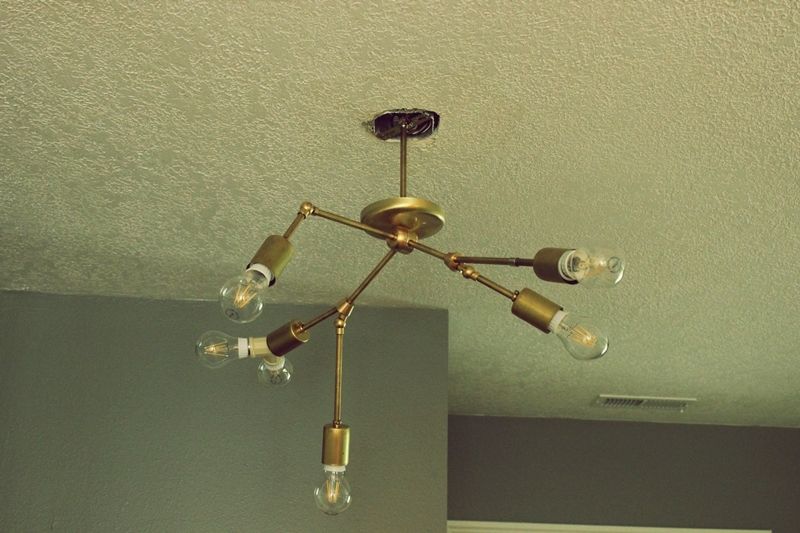
Step 14: Wire chandelier to existing light wiring in ceiling.

Step 12: Find the ceiling canopy and slide it onto the vertical pipe.

Step 13: Screw vertical pipe into ceiling mount. Be careful to not let the branches hit your face as you screw the chandelier in! Take your time, use a second set of hands if necessary.

Step 14: Wire chandelier to existing light wiring in ceiling.
Step 15: Test it out. Flip the breaker switch to return power, then cross your fingers and turn on your chandelier. Hopefully it works like a charm! You’re so close to being done.
Step 16: Attach ceiling canopy. I’d recommend flipping the breaker switch to turn electrical off here, then attach the ceiling canopy before turning the electrical back on.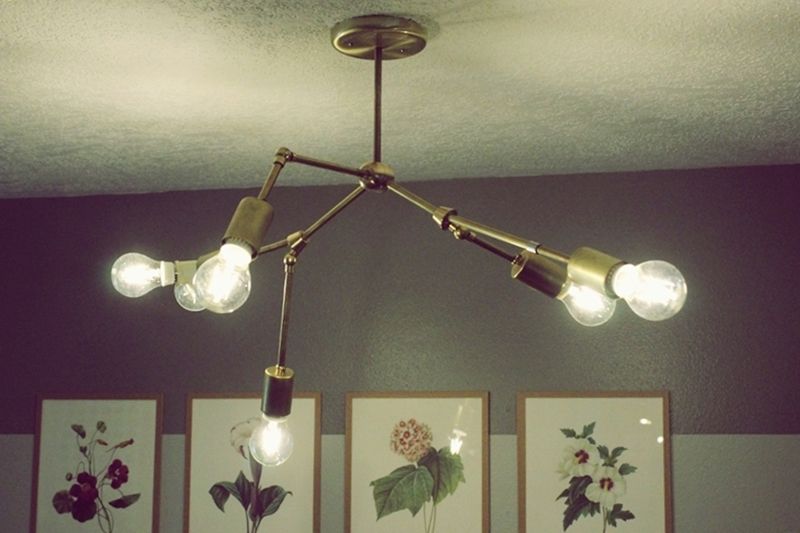

Step 17: Pat yourself on the back for a job well done. Enjoy your new chandelier and the many trips you’re about to make into your space just to admire it.
We hope you find this tutorial helpful and that you find success in creating your own beautiful brass chandelier!
Source: www.homedit.com




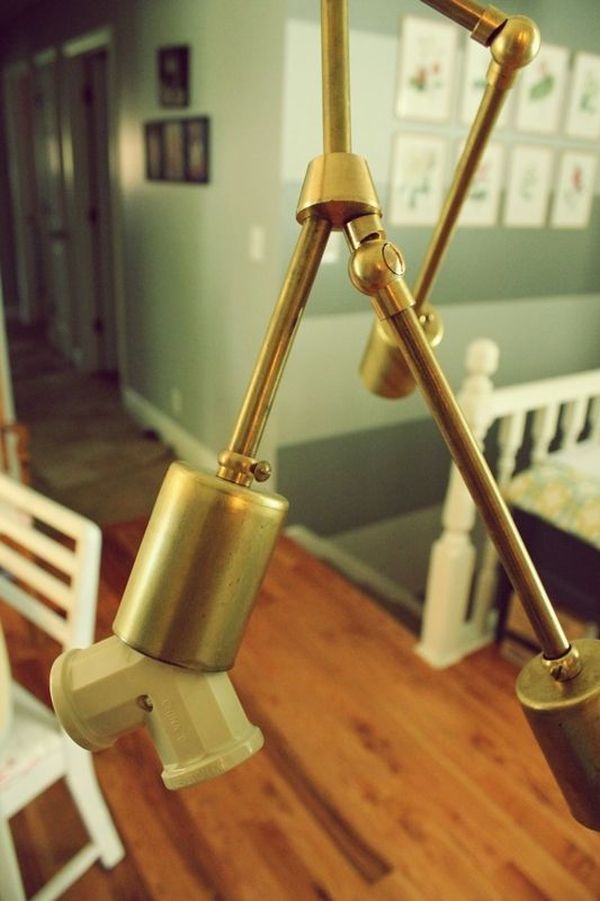




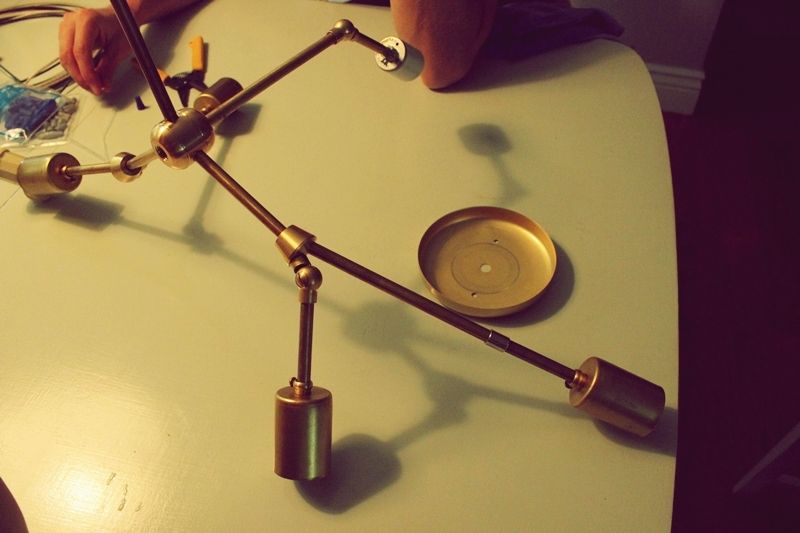












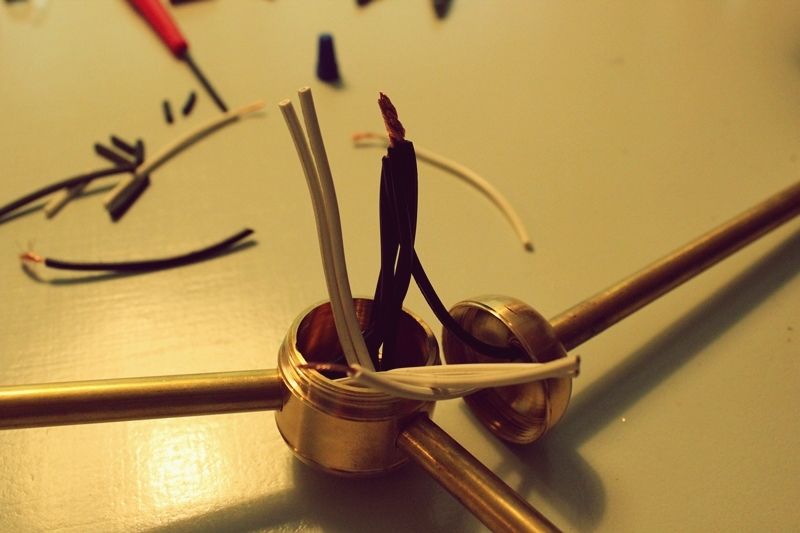








Comments
Post a Comment